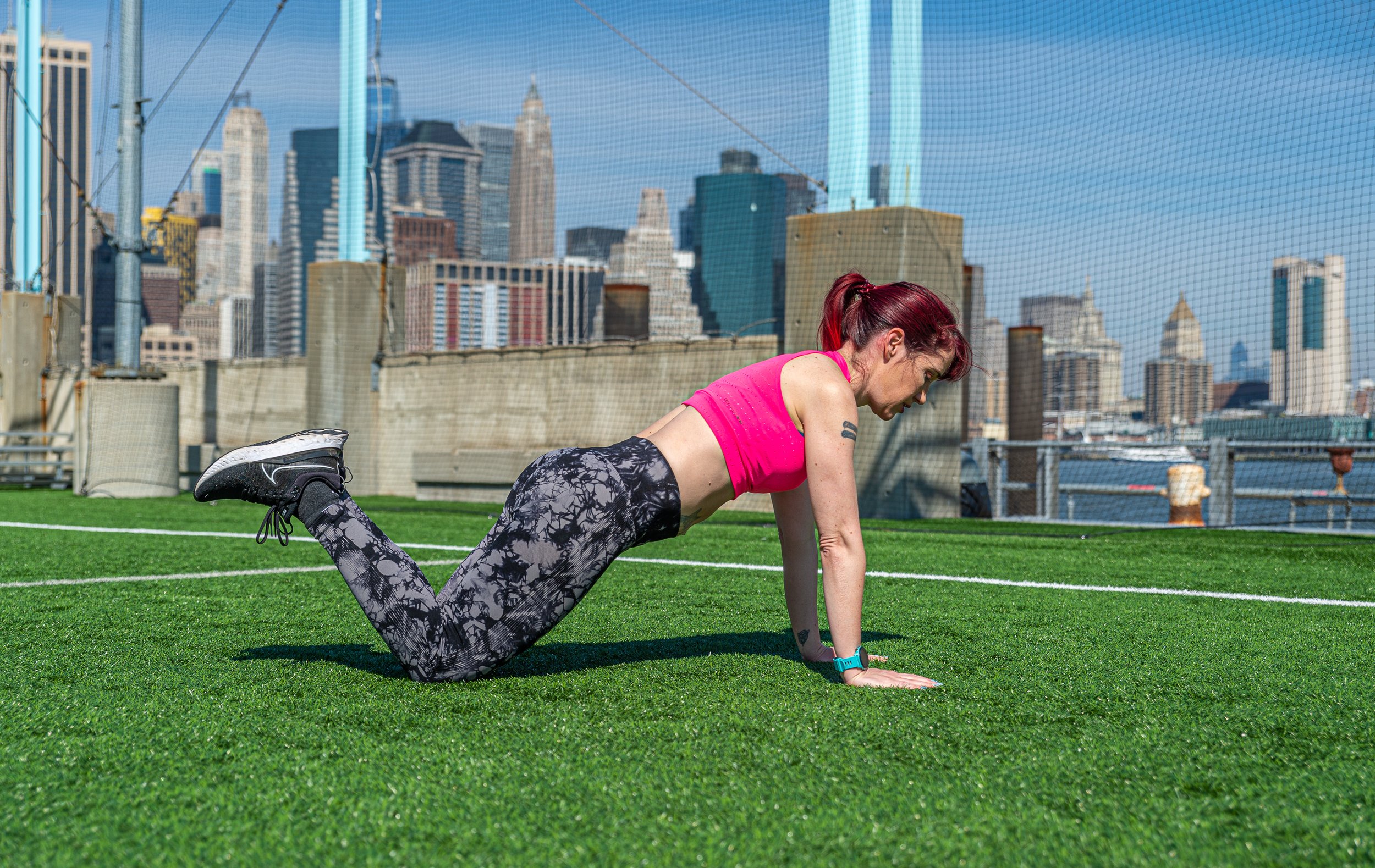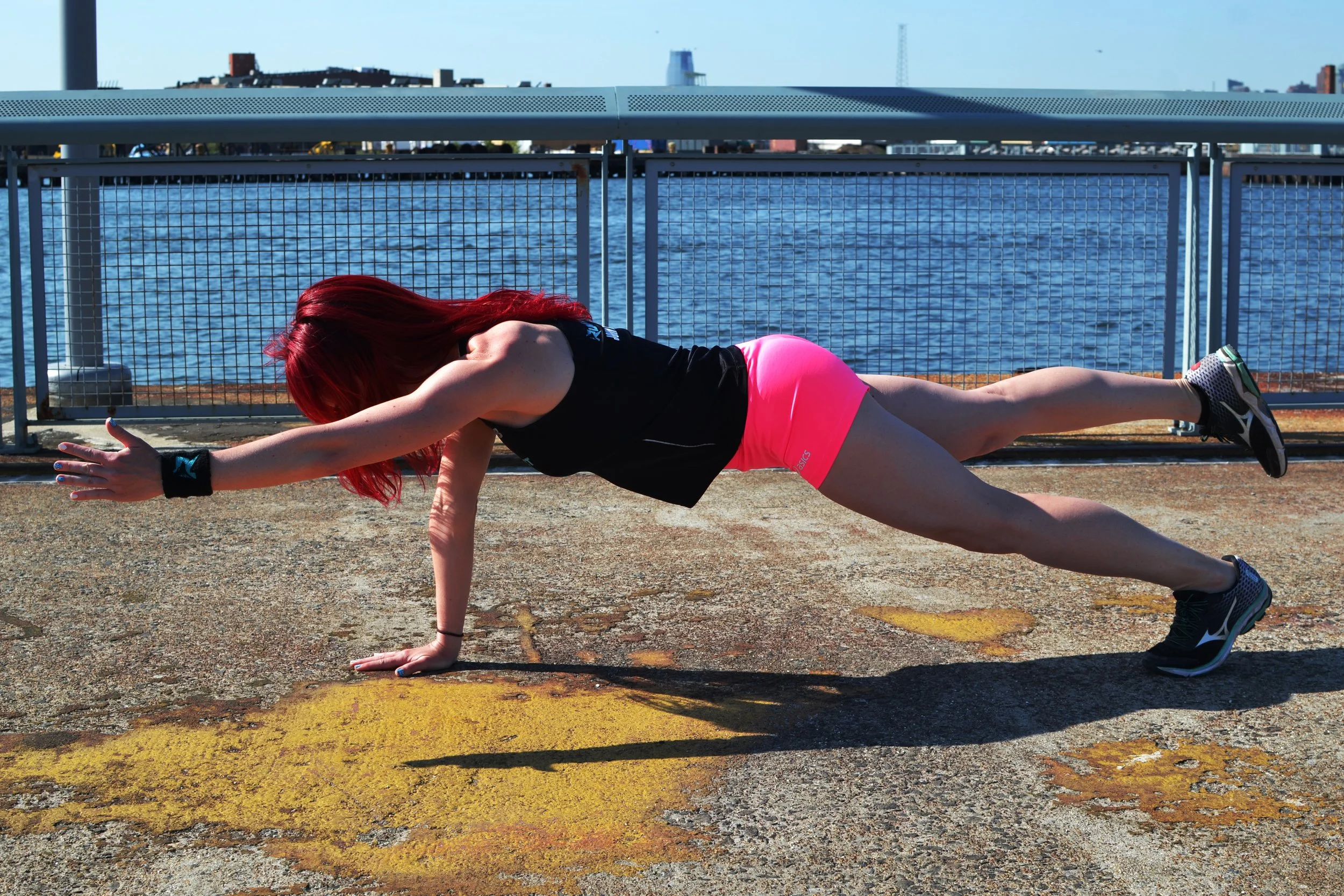How to Do a Straight Arm Plank
By Marnie Kunz, NASM-certified trainer, USATF-, RRCA-certified running coach
If you want to know how to do a straight arm plank - or high plank - correctly, this post is for you. As a trainer and running coach, I often find myself recommending planks to people because they have so many benefits without the pressure on the neck and spine that situps can have. This guide will walk you through the benefits of planks, and offer tips on how to do straight arm planks with good form. We will also go over some plank variations in case you want to modify your planks or make them more challenging.
Related Video: How to Do High Planks Related Post: 10 Best Ab Exercises with Dumbbells
You can do planks almost anywhere, with no equipment. Photo by Marques Jackson Photography.
What Is a Straight Arm Plank?
First of all, you may be wondering what is a straight arm plank. With so many types of planks, it can be confusing to know what kind of planks people are referring to. A straight arm plank - also called a high plank - is a form of plank where you have your arms extended straight, with your shoulders in line with your elbows and wrists and hands planted on the floor.
When you do a high plank - or straight arm plank - you are holding yourself up in a high push-up position, with your feet and hands planted on the floor, core tight, and body in a straight line.
High Planks Vs. Forearm Planks
This is different from a forearm plank, where you rest your bodyweight in your forearms. Forearm planks are a variation of planks that are especially helpful for beginners or people who want to place less pressure on the hands and wrists.
Straight Arm Planks Muscles Worked
High planks are a great full-body exercise to strengthen your core muscles and your upper body muscles, including your rectus abdominis (the “six-pack” abs muscle), obliques, transverse abdominis, shoulders, biceps, triceps, and chest muscles. When you do a straight arm plank, you also get some strengthening of your lower body muscles including the hamstrings, glutes, and calves. These planks are a staple in so many fitness programs for a reason - they offer lots of strengthening benefits, especially for your core and upper body.
High Plank Benefits
There are many benefits of doing straight arm planks, from improving your balance and posture to helping your sports performance. Here are some of the benefits of doing high planks:
Improves core strength and core endurance.
Improves your balance and stability. This makes daily activities easier and helps prevent injuries.
Lower risk of getting injured than core exercises like sit-ups and crunches, which put more pressure on the neck and spine.
Improves sports performance. Straight arm planks help improve your athletic performance for exercises ranging from running to throwing.
Adaptable to all fitness levels. You can make your planks more or less challenging. If you’re a beginner, you can do modified planks (see more on those below), and if you’re advanced, you can add intensity by doing shoulder taps or lifting one leg at a time during your planks.
How to Do Straight Arm Planks
You can do modified high planks by bending your knees.
A straight arm plank is similar to the high position of a push-up. Here is how to do a straight arm plank:
Begin on the floor on all fours, with your torso parallel to the floor. Make sure your arms are straight and your hands are planted slightly wider than your shoulders on the mat.
Straighten your legs, bringing your knees off the floor while keeping your feet planted on the floor, shoulder-width apart. Keep your head and neck in a neutral position, with your head facing down.
Tighten your core muscles and glutes and hold this position. Your body should be in a straight line from your head down to your toes, with your head and neck in a neutral position.
Modified Straight Arm Planks
If you’re not quite ready for straight arm planks, you can do modified planks. To do these, begin from a high plank position and then lower your knees to the floor, with your lower legs stretched out behind you on the floor. This takes some of your body weight off of your hands and feet and still works your core muscles. Keep your core and glutes tight and your upper body in a straight line.
Once you can do at least 30 seconds of modified high planks, try doing the regular straight arm plank for 20 seconds.
Another option is to do forearm planks. For these, you will bend your elbows and balance your entire body on your forearms and your toes, with your elbows to your hands resting on the ground. Forearm planks are better suited to anyone with wrist or hand injuries because they take pressure off your hands.
You can make your straight arm planks more intense by picking up alternating arms and legs.
Advanced Straight Arm Planks
To add intensity to your high planks, you can alternately lift one arm or one arm and one leg when you plank. Here’s how to do advanced planks:
Begin with your arms planted below your shoulders and your feet hip-width apart on the floor.
Get into a high plank position, keeping your core muscles tight and your glutes engaged.
Slowly raise your right arm. For an even more challenging movement, raise your right arm and left leg at the same time.
Keep your core tight to hold your body in a straight line plank position.
Slowly lower your right arm and left leg.
Slowly raise your left arm up toward the ceiling. For an even greater challenge, also raise your right leg.
Hold for a few seconds then lower your arm and leg.
Repeat on both sides for a total of 30 seconds.
Tips for High Planks
Don’t let your hips sag toward the ground. Make sure you keep your core tight and your body in a straight line.
Don’t let your butt inch up in an attempt to make the planks easier. Keep your glutes tight and your body in a straight line.
Keep your head down and your neck in a neutral position. Don’t strain your neck or try to look up.
Remember to breathe! Count your breathing if it helps you focus and maintain your plank form.
If you have any shoulder or arm injuries, do not do high planks. Consult your doctor for approval to begin doing high planks after an upper-body injury.
Photo by Marques Jackson Photography.
How Long to Do Planks
When you are first starting out doing straight arm planks, do 20 seconds to start. You should be able to maintain good form and keep your body in a straight line when you do planks. If you find your form collapsing, you can shorten the duration of your planks and build up to doing longer ones. If you’re a beginner, you can do modified high planks for 20 seconds and work on your core strength to build up to doing regular straight arm planks.
After you do one set of planks, you can take a break for at least 10 seconds and repeat to do at least two reps. Do 2 to 3 sets of planks total. As you get stronger, you can gradually increase your plank time to 30 seconds, then 45 seconds, and eventually 60 seconds.
If you’re looking for more core exercises to get stronger abs, check out these 3 Core Exercises to Torch Your Abs. For a more intense ab workout, you can add a dumbbell to many core exercises. Download my free Dumbbell Ab Exercises to get started.
Have you tried straight arm planks? What do you think? Tag me on the Runstreet Instagram to share your workouts and get cheered on. Happy sweating to you!😊
Related Posts: 3 Best Core Exercises, How to Do Mountain Climbers, How to Do Home Workouts Without Equipment
Marnie Kunz is a NASM-certified personal trainer and USATF- and RRCA-certified running coach based in Brooklyn, NY. Marnie likes helping people get and stay active to enjoy a better quality of life. When she’s not doing fitness things, Marnie enjoys exploring with her dog, a mischievous rescue Akita.





